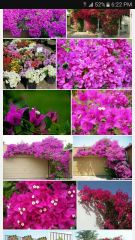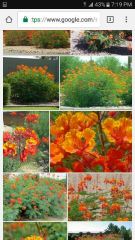![]()
![]()
![]()
Use LEFT and RIGHT arrow keys to navigate between flashcards;
Use UP and DOWN arrow keys to flip the card;
H to show hint;
A reads text to speech;
3 Cards in this Set
- Front
- Back
- 3rd side (hint)

Bougainvilea |
Family: Nyctaginaceae (nyk-taj-i-NAY-see-ee) Genus: Bougainvillea (boo-gan-VIL-lee-uh)Cultivar: Barbara Karst Water Requirements:Average Water Needs; Water regularly; do not overwater Height:8-10 ft. (2.4-3 m)Spacing:6-8 ft. (1.8-2.4 m) Hardiness:USDA Zone 10a: to -1.1 °C (30 °F)USDA Zone 10b: to 1.7 °C (35 °F)USDA Zone 11: above 4.5 °C (40 °F) Sun Exposure:Full Sun Danger:Plant has spines or sharp edges; use extreme caution when handling Bloom Color:Magenta (Pink-Purple)RedScarlet (Dark Red)Bloom Time:Blooms repeatedlyFoliage:EvergreenSmooth-Textured Other details:May be a noxious weed or invasive Propagation MethodsFrom herbaceous stem cuttingsFrom woody stem cuttingsFrom softwood cuttingsFrom semi-hardwood cuttingsSeed Collecting:N/A: plant does not set seed, flowers are sterile, or plants will not come true from seed |
Category-ShrubsTropicals and Tender PerennialsVines and Climbers |
|

Texas ranger |
Leucophyllum fruitescens has many common names, including Texas ranger, Texas sage, Texas rain sage, barometer bush, cenizo, silverleaf, and ash-leaf Texas rangers are in the Snapdragon Family (Scrophulariaceae).Texas rangers are medium-sized shrubs, typically to 8 feet tall and wide. They are covered with small gray or gray-green leaves. Plants are usually evergreen but some cultivars may go deciduous during the coldest winters. The flowers are usually less than an inch wide, but are so abundant in number that they put on a beautiful show of purple, pink, or white blooms. Blooming is from summer into fall and usually quickly follows rain or even high humidity. Each bloom cycle does not last particularly long but plants can bloom repeatedly. Plants should be grown in full sun, in well draining soil, and with little to moderate water. Over-watered plants will die out and under-watered plants will drop many leaves and look scraggly. The species is tolerant of alkaline soils, heat, and wind |
Leucophyllum fruitescens |
|

Red bird of paradise |
pulcherrima Red Bird of Paradise Background or specimen shrub; origin unknown due to widespread cultivation; widely distributed and naturalized in tropical areas of America 4 to 10 feet with spread of 4 to 6 feet; grows rapidly; mature size determined by irrigation and severity of winters Water Every month once established; water every week during spring and summer for continuous blooms Damaged at 32° F Full sun/light shade avoid northern light exposure |
pulcherrima |

